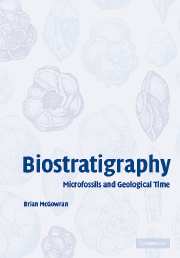Book contents
- Frontmatter
- Contents
- Preface
- Acknowledgments
- 1 Biogeohistory and the development of classical biostratigraphy
- 2 The biostratigraphy of fossil microplankton
- 3 Biostratigraphy: its integration into modern geochronology
- 4 Biostratigraphy and biohistorical theory I: evolution and correlation
- 5 Systemic stratigraphy: beyond classical biostratigraphy
- 6 Biostratigraphy and biohistorical theory II: carving Nature at the joints
- 7 Biostratigraphy and chronostratigraphic classification
- 8 On biostratigraphy and biogeohistory
- References
- Index
7 - Biostratigraphy and chronostratigraphic classification
Published online by Cambridge University Press: 02 December 2009
- Frontmatter
- Contents
- Preface
- Acknowledgments
- 1 Biogeohistory and the development of classical biostratigraphy
- 2 The biostratigraphy of fossil microplankton
- 3 Biostratigraphy: its integration into modern geochronology
- 4 Biostratigraphy and biohistorical theory I: evolution and correlation
- 5 Systemic stratigraphy: beyond classical biostratigraphy
- 6 Biostratigraphy and biohistorical theory II: carving Nature at the joints
- 7 Biostratigraphy and chronostratigraphic classification
- 8 On biostratigraphy and biogeohistory
- References
- Index
Summary
Summary
Timescales could be as diverse as major taxic groups (e.g. an ammonite scale and a foraminiferal scale), realms (marine and terrestrial scales), or provinces (Paratethyan and Australasian provincial scales) themselves are diverse. Clearly we need a central reference controlling such potential exuberance. The key distinction is between the framework category, the decisions and rules and stratigraphic codes that make orderly progress possible by increasing communication and reducing confusion, and the phenomenon category, in which all the actual scientific disciplines comprising biogeohistory can cross-fertilize and flourish. Thus we can always improve the date of an event, we can always clarify the succession of speciations and extinctions (especially between major taxa) and such matters cannot be resolved by democratic processes. Therefore, we need agreed reference sections in the rocks (boundary stratotypes) for boundaries in the standard timescale (e.g. the Cretaceous–Palaeogene, Eocene–Oligocene, Palaeogene–Neogene boundaries) which are decided by vote but only on the basis of all available rigorous science. Meanwhile, there remains a role for regional scales which have to tie together neritic and terrestrial facies, or which are essentially biochronological. Such scales are subject to codes but the actual active use of each scheme in its unique context is the only test of its value.
Introduction: why do we need a geological timescale?
The core and soul of geology are captured in a terse phrase: rock relationships and Earth history. Stratigraphy is the study of successions of rocks and their interpretation as sequences of events in Earth history.
- Type
- Chapter
- Information
- BiostratigraphyMicrofossils and Geological Time, pp. 271 - 345Publisher: Cambridge University PressPrint publication year: 2005

